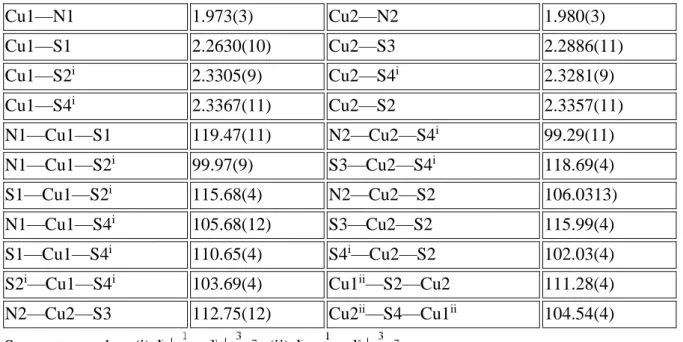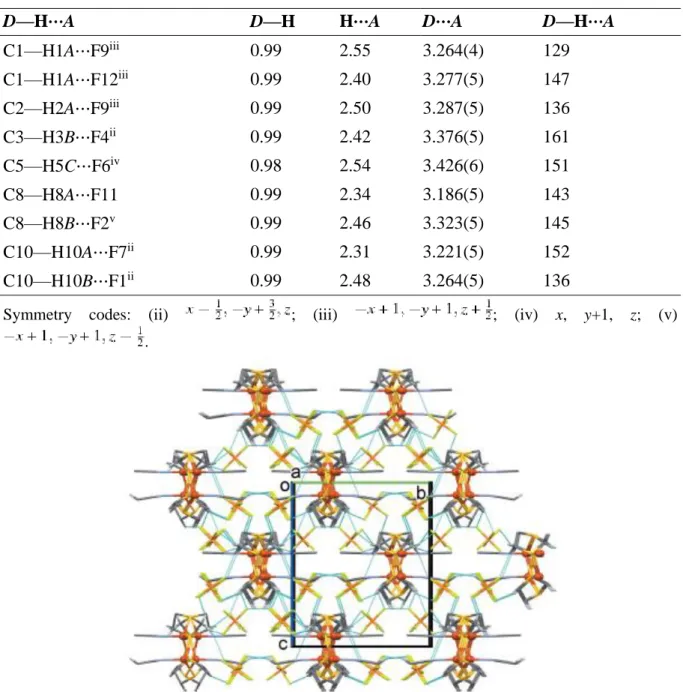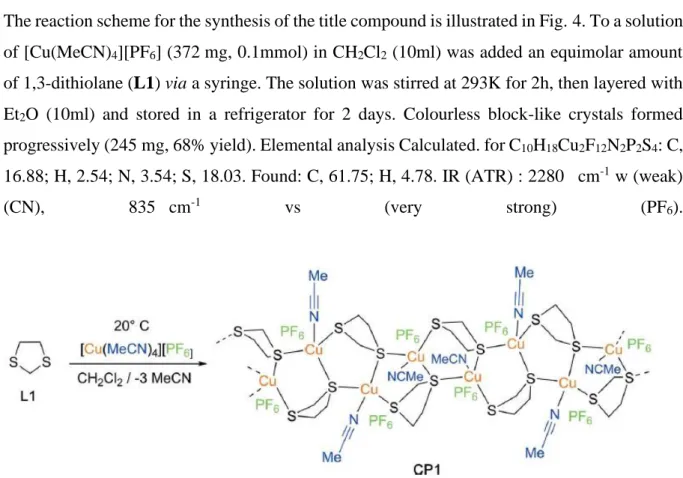HAL Id: hal-02469653
https://hal.archives-ouvertes.fr/hal-02469653
Submitted on 16 Nov 2020HAL is a multi-disciplinary open access archive for the deposit and dissemination of sci-entific research documents, whether they are pub-lished or not. The documents may come from teaching and research institutions in France or abroad, or from public or private research centers.
L’archive ouverte pluridisciplinaire HAL, est destinée au dépôt et à la diffusion de documents scientifiques de niveau recherche, publiés ou non, émanant des établissements d’enseignement et de recherche français ou étrangers, des laboratoires publics ou privés.
Crystal structure of the coordination polymer catena
-poly[[[(acetonitrile-κ N )copper(I)]-µ 3 -1,3-dithiolane-κ
3 S : S : S ’] hexafluoridophosphate]
Lena Knauer, Michael Knorr, Lydie Viau, Carsten Strohmann
To cite this version:
Lena Knauer, Michael Knorr, Lydie Viau, Carsten Strohmann. Crystal structure of the coordination polymer catena -poly[[[(acetonitrile-κ N )copper(I)]-µ 3 -1,3-dithiolane-κ 3 S : S : S ’] hexafluoridophos-phate]. Acta crystallographica. Section E, Crystallographic communications, International Union of Crystallography, 2020, 76 (1), pp.38-41. �10.1107/S205698901901627X�. �hal-02469653�
Crystal structure of the coordination polymer catena-(tris((µ
2-1,3-dithiolane-S,S,S')-(acetonitrile)-copper(I)hexafluorophosphate)
Lena Knauer,a Michael Knorr,b* Lydie Viaub and Carsten Strohmann*a
aAnorganische Chemie, Technische Universität Dortmund, Otto-Hahn-Strasse 6, D-44227
Dortmund, Germany, and bInstitut UTINAM UMR 6213 CNRS, Université Bourgogne
Franche-Comté, 16 Route de Gray, 25030 Besançon Cedex, France
Correspondence e-mail: michael.knorr@univ-fcomte.fr; carsten.strohmann@tu-dormund.de
Keywords: crystal structure; copper complex; coordination polymer; thioether ; C-H…F
hydrogen bonding
Abstract
The polymeric title compound, [Cu2(C2H3N)2(C3H6S2)2](PF6)2, represents an example of a
one-dimensional coordination polymer resulting from the reaction of [Cu(MeCN)4][PF6] with
1,3-dithiolane. The cationic one-dimensional ribbon consists of two copper(I) centers each ligated by one acetonitrile molecule and interconnected through two bridging 1,3-dithiolane ligands.
One S-donor site of each ligand is κ1-bound to Cu, whereas the second S atom acts as a
four-electron donor, bridging two Cu atoms in a κ4-bonding mode. The positive charge of each
copper cation is compensated for by a hexafluoridophosphate counter-ion. In the crystal, the polymer chains are linked by a series of C—H⋯F hydrogen bonds, forming a supramolecular framework.
1. Chemical Context
The five-membered heterocyclic ligand tetrahydrothiophene (THT) is known to form a great variety of molecular complexes and coordination polymers (CPs) with various transition metals. Notably, for the soft coinage metal ions Cu(I), Ag(I) and Au(I), numerous structurally characterized examples coordinated by terminal or bridging THT ligands are documented (Ahrland et al., 1993; Dembo et al., 2010; Noren & Oskarsson, 1985; Mälger et al., 1992; Uson
penta-µ-chloro-tris-µ-tetrahydrothiophene-tetracopper(I,II) have been prepared (Ainscough et al., 1985). In the
case of the five-membered heterocycle 1,2-dithiolane, in which one CH2-unit is replaced by a
second sulfur atom, there is one report on its coordination to Hg2(NO3)2 yielding the Hg(I)
adduct 1,2-dithiolane • Hg2(NO3)2 (Brodersen & Rölz, 1977). Furthermore, the dinuclear
organometallic species [η5-CpMn(CO)2(µ2-1,2-dithiolane)]2 has been crystallographically
characterized (Braunwarth et al., 1991). The fluxional complexes [M(CO)5(1,3-dithiolane)] (M
= Cr, Mo, W) ligated by the isomeric heterocycle 1,3-dithiolane (1,3-dithiacyclopentane) have been investigated by NMR spectroscopy (Abel et al., 1990). In a comparative study with respect to our previous work on the coordination chemistry of the open-chain dithioether analogues
RS-CH2-SR (Chaabéne et al., 2016; Knorr et al., 2014; Peindy et al., 2007) and in part to fill
the gap between the versatile coordination chemistry of THT (see above) and the almost unexplored coordination chemistry of 1,3-dithiolane, we recently described in detail the construction and structural features of molecular clusters and coordination networks, with dimensionalities varying from 0D-2D by reacting 1,3-dithiolane and its ferrocenyl derivative substituted at the 2-position with CuX salts (X = Cl, Br, I) (Raghuvanshi et al., 2017). But surprisingly, a survey of the CSD Database reveals that apart from our CuX • 1,3-dithiolane compounds no other unsubstituted 1,3-dithiolane complexes have been structurally characterized. We have now extended our project on the coordination chemistry of this cyclic
dithioether using [Cu(MeCN)4][PF6] as reactant to obtain an ionic salt-like material, which
could be interesting for electrochemical investigation.
2. Structural commentary
We have previously described the structural features of the ribbon-like structures of compounds
[{Cu(µ2-Br)}(µ2-L1)]n and [{Cu(µ2-Cl)}(µ2-L1)]n, formed upon treatment of CuBr and CuCl
with 1,3-dithiolane L1 (Raghuvanshi et al., 2017). The title complex salt,, a ribbon of
composition [Cu(1,3-dithiane)(MeCN)]n+ (CP1) also results from the reaction of
[Cu(MeCN)4][PF6] with L1, but its architecture is quite different.The molecular structure of the
asymmetric unit off the title complex is illustrated in Fig. 1, and selected bond lengths and bond
angles are given in Table 1. The ribbon-like structure is built upon individual CuI atoms, each
ligated by a datively bound MeCN ligand and interconnected to the neighbouring metal centers by two bridging dithiolane ligands (Fig. 2). Overall, the architecture of CP1 is quite reminiscent
of that of the 1D polymeric tetrafluoridoborate salt [Cu(1,3-dithiane)(MeCN)]n+ (Knaust &
Keller, 2003). Nevertheless, there is one difference. Whereas the asymmetric unit of the latter
copper(I) centers, that of CP1 (crystallizing in the orthorhombic non-centrosymmetric space
group Pna21) contains only two unique CuI atoms. Each displays a CuNS3 four-coordinate
environment; see Table 1 [L—Cu—L angles: 99.97 (7) to 119.47 (11)° for Cu1, and 99.29 (11)
to 118.69 (4)° for Cu2]. The τ4 descriptor for fourfold coordination is = 0.89 for both atoms
Cu1 and Cu2, indicating that each have a trigonal-pyramidal geometry (τ4 = 1 for a perfect
tetrahedral geometry, = 0 for a perfect square planar geometry and = 0.85 for a perfect
trigonal-pyramidal geometry; Yang et al., 2007). The coordination environment for each of the CuI
centers includes three bridging dithiolane ligands and one terminal acetonitrile ligand. All Cu— S bond lengths are in the range 2.2630(10)–2.3367(11)Å, the mean Cu—S bond length of
2.314(12)Å is quite similar to that in [Cu(1,3-dithiane)(MeCN)]n+. In addition, the mean Cu—
N bond distance matches well with that of [Cu(1,3-dithiane)(MeCN)]n [1.979 (4) versus 1.984
(7) Å]. The three dithiolane ligands each have one S atom that is a two-electron donor and one
S atom that is a μ2-four-electron donor. The Cu⋯Cu separations of ca 3.689–3.852 Å are far
above the sum of the van der Waals radii of two Cu atoms (2.8 Å), excluding any bonding interaction. These two bonding modes lead to the formation of a ribbon-like coordination
polymer, which runs parallel to the a axis, where each copper(I) center is bonded to two μ2-S
atoms and one μ1-S atom (Fig. 2 and Table 1).
Table 1 Selected geometric parameters (Å, °)
Cu1—N1 1.973(3) Cu2—N2 1.980(3) Cu1—S1 2.2630(10) Cu2—S3 2.2886(11) Cu1—S2i 2.3305(9) Cu2—S4i 2.3281(9) Cu1—S4i 2.3367(11) Cu2—S2 2.3357(11) N1—Cu1—S1 119.47(11) N2—Cu2—S4i 99.29(11) N1—Cu1—S2i 99.97(9) S3—Cu2—S4i 118.69(4) S1—Cu1—S2i 115.68(4) N2—Cu2—S2 106.0313) N1—Cu1—S4i 105.68(12) S3—Cu2—S2 115.99(4) S1—Cu1—S4i 110.65(4) S4i—Cu2—S2 102.03(4)
S2i—Cu1—S4i 103.69(4) Cu1ii—S2—Cu2 111.28(4)
N2—Cu2—S3 112.75(12) Cu2ii—S4—Cu1ii 104.54(4)
Figure 1. A view of the asymmetric unit of the title compound, with atom labelling [symmetry codes: (i) x − , −y + , z; (ii) x + , −y + , z]. Displacement ellipsoids are drawn at the 30% probability level
Figure 2. A partial view along the b axis of the crystal packing of the title compound. For clarity, the H atoms and the PF6− anions have been omitted.
3. Supramolecular features
The crystal packing of the title compound is illustrated in Fig.3, and shows the ribbon-like structures, propagating along the a-axis direction, that are linked by a number of C—H⋯F hydrogen bonds, forming a supramolecular framework (Fig 3 and Table 2).
Table 2. Hydrogen-bond geometry (Å, °)
D—H⋯A D—H H⋯A D⋯A D—H⋯A
C1—H1A⋯F9iii 0.99 2.55 3.264(4) 129 C1—H1A⋯F12iii 0.99 2.40 3.277(5) 147 C2—H2A⋯F9iii 0.99 2.50 3.287(5) 136 C3—H3B⋯F4ii 0.99 2.42 3.376(5) 161 C5—H5C⋯F6iv 0.98 2.54 3.426(6) 151 C8—H8A⋯F11 0.99 2.34 3.186(5) 143 C8—H8B⋯F2v 0.99 2.46 3.323(5) 145 C10—H10A⋯F7ii 0.99 2.31 3.221(5) 152 C10—H10B⋯F1ii 0.99 2.48 3.264(5) 136
Symmetry codes: (ii) ; (iii) ; (iv) x, y+1, z; (v)
.
Figure 3. A view along the a axis of the crystal packing of the title compound. The C—H⋯F hydrogen bonds (Table 2) are shown as dashed lines. For clarity, only the H atoms involved in these interactions have been included.
4. Data survey
Other examples of crystallographically characterized 1,3-dithiolane complexes substituted at
the 2 position found in the Cambridge Stuctural Database include catena-[(µ5
-1,3-Dithiolane-2-carboxylato)-(µ4-1,3-dithiolane-2- carboxylato)-(µ2
-trifluoromethanesulfonato-O,O')-tri-silver(I)] (FAQIPY; Gondi et al., 2011), catena-((µ3-1,3-Dithiolane-2-methanol-S,S,S')-(nitrato-O)-silver(I)) (HESLUN; Zhang et al. 2006),
Chloro-triphenylphosphine-(2,5-bis(1,3-dithiolan-2-yl)phenyl-S)- palladium(II) (IVUFEK;Vicente et al. 2004), rac-trans-Dichloro-bis((2-(1,3-dithiolan-2-yl)phenyl)(diphenyl)phosphine)- ruthenium(II) chloroform solvate (TUMOK; Bayly et al. 2009). Other examples of related 1,3-dithiane copper (I) coordination polymers have also been reported (Raghuvanshi et al. 2019).
5. Synthesis and crystallization
The reaction scheme for the synthesis of the title compound is illustrated in Fig. 4. To a solution
of [Cu(MeCN)4][PF6] (372 mg, 0.1mmol) in CH2Cl2 (10ml) was added an equimolar amount
of 1,3-dithiolane (L1) via a syringe. The solution was stirred at 293K for 2h, then layered with
Et2O (10ml) and stored in a refrigerator for 2 days. Colourless block-like crystals formed
progressively (245 mg, 68% yield). Elemental analysis Calculated. for C10H18Cu2F12N2P2S4: C,
16.88; H, 2.54; N, 3.54; S, 18.03. Found: C, 61.75; H, 4.78. IR (ATR) : 2280 cm-1 w (weak)
(CN), 835 cm-1 vs (very strong) (PF
6).
Figure 4. Reaction scheme for the synthesis of the title compound, CP1.
6. Refinement
Crystal data, data collection and structure refinement details are summarized in Table 3. The C-bound H atoms were included in calculated positions and treated as riding: C—H = 0.98–
0.99Å with Uiso(H) = 1.5Ueq(C-methyl) and 1.2Ueq(C) for other H atoms. The structure was
refined as a two-component inversion twin BASF = 0.121(12). In the final cycles of refinement three reflections were omitted; one was affected by the backstop and two were most disagreeable reflections
Table 3. Experimental details
Chemical formula C10H18Cu2N2S4·2(F6P)
Mr 711.52
Crystal system, space group Orthorhombic, Pna21 Temperature (K) 105 a, b, c (Å) 11.8409 (9), 12.9273 (9), 15.2921 (11) V (Å3) 2340.8 (3) Z 4 Radiation type Mo Kα µ (mm−1) 2.41 Crystal size (mm) 0.33 × 0.32 × 0.27 Data collection
Diffractometer Bruker D8 VENTURE area detector
Absorption correction Multi-scan TWINABS-2012/1 (Bruker,2012) was used for absorption correction. Tmin, Tmax 0.608, 0.746 No. of measured, independent and observed [I > 2σ(I)] reflections 7731, 7136, 6518 Rint 0.100 (sin θ/λ)max (Å−1) 0.715 Refinement R[F2 > 2σ(F2)], wR(F2), S 0.035, 0.080, 1.05 No. of reflections 7136 No. of parameters 292 No. of restraints 1
H-atom treatment H-atom parameters constrained
Δρmax, Δρmin (e Å−3) 0.48, −0.44
Absolute structure Flack x determined using 2796 quotients [(I+)-(I-)]/[(I+)+(I-)]
(Parsons, Flack and Wagner, Acta Cryst. B69 (2013) 249-259). Absolute structure
parameter
0.004 (9)
Computer programs: APEX2 and SAINT (Bruker, 2016), SHELXT (Sheldrick, 2015a), SHELXL (Sheldrick, 2015b), OLEX2 (Dolomanov et al., 2009), Mercury (Macrae et al., 2008), PLATON (Spek, 2009) and publCIF (Westrip, 2010).
Acknowledgements
Lena Kauer would like to thank the “Fonds der Chemischen Industrie” for a doctoral fellowship.
ReferencesAbel, E. W., Orrell, K. G., Qureshi, K. B. & Sik, V. (1990). Polyhedron 9,
703-711.
Ahrland, S., Dreisch, K., Noren, B. & Oskarsson, A. (1993). Mater. Chem. Phys. 35, 281-289. Ainscough, E. W., Brodie, A. M., Husbands, J. M., Gainsford, G. J., Gabe, E. J. & Curtis, N. F. (1985). J. Chem. Soc., Dalton Trans. 151-158.
Bayly, S. R., Cowley, A. R., Dilworth, J. R. & Ward, C. V. (2009). Eur. J. Inorg. Chem. 3807-3813.
Braunwarth, H., Lau, P., Huttner, V., Minelli, M., Guenauer, V., Zsolnai, V., Jibril, I. & Evertz, V. (1991). J. Organomet. Chem. 411, 383-394.
Brodersen, K. & Rölz, W. (1977). Chem. Ber. 110, 1042-1046.
Chaabéne, M., Khatyr, A., Knorr, M., Askri, M., Rousselin, Y. & Kubicki, M. M. (2016). Inorg.
Chim. Acta 451, 177-186.
Dembo, M. D., Dunaway, L. E., Jones, J. S., Lepekhina, E. A., McCullough, S. M., Ming, J. L., Li, X., Baril-Robert, F., Patterson, H. H., Bayse, C. A. & Pike, R. D. (2010). Inorg. Chim. Acta
364, 102-114.
Dolomanov, O. V., Bourhis, L. J., Gildea, R. J., Howard, J. A. K. & Puschmann, H. (2009). J.
Appl. Cryst. 42, 339–341.
Gondi, S. R., Zhang, H. & Son, D. Y. (2011). J. Sulfur Chem. 32, 17-21.
Groom, C. R., Bruno, I. J., Lightfoot, M. P. & Ward, S. C. (2016). Acta Cryst. B72, 171–179. Knaust, J. M. & Keller, S. W. (2003). CrystEngComm, 5, 459–465
Knorr, M., Khatyr, A., Dini Aleo, A., El Yaagoubi, A., Strohmann, C., Kubicki, M. M., Rousselin, Y., Aly, S. M., Fortin, D., Lapprand, A. & Harvey, P. D. (2014). Cryst. Growth Des.
14, 5373-5387.
Macrae, C. F., Bruno, I. J., Chisholm, J. A., Edgington, P. R., McCabe, P., Pidcock, E., Rodriguez-Monge, L., Taylor, R., van de Streek, J. & Wood, P. A. (2008). J. Appl. Cryst. 41, 466–470.
Mälger, H., Olbrich, F., Kopf, J., Abeln, D. & Weiss, E. (1992). Z. Naturforsch. 47b, 1276-1280.
Noren, B. & Oskarsson, A. (1985). Acta Chem. Scand. A39, 701-709 .
Peindy, H. N., Guyon, F., Khatyr, A., Knorr, M. & Strohmann, C. (2007). Eur. J. Inorg. Chem. 1823-1828.
Raghuvanshi, A., Dargallay, N. J., Knorr, M., Viau, L., Knauer, L. & Strohmann, C. (2017). J.
Raghuvanshi, A., Knorr, M., Knauer, L., Strohmann, C., Boullanger, S., Moutarlier, V. & Viau, L. (2019). Inorg. Chem., 58, 5753-5775.
Sheldrick, G. M. (2015a). Acta Cryst. A71, 3–8. Sheldrick, G. M. (2015b). Acta Cryst. C71, 3–8. Spek, A. L. (2009). Acta Cryst. D65, 148–155.
Uson, R., Laguna, A., Laguna, M., Manzano, B. R., Jones, P. G. & Sheldrick, G. M. (1984). J.
Chem. Soc., Dalton Trans. 285-292.
Vicente, J., Abad, J.-A., Hernández-Mata, F. S., Rink, B., Jones, P. G. & Ramírez de Arellano, M. C. (2004). Organometallics 23, 1292-1304.
Westrip, S. P. (2010). J. Appl. Cryst. 43, 920–925.
Yang, L., Powell, D. R. & Houser, R. P. (2007). Dalton Trans. 955–964. Zhang, H., Son, D. Y. & Gondi, S. R. (2006). Acta Cryst. E, 62, m3086-m3088



